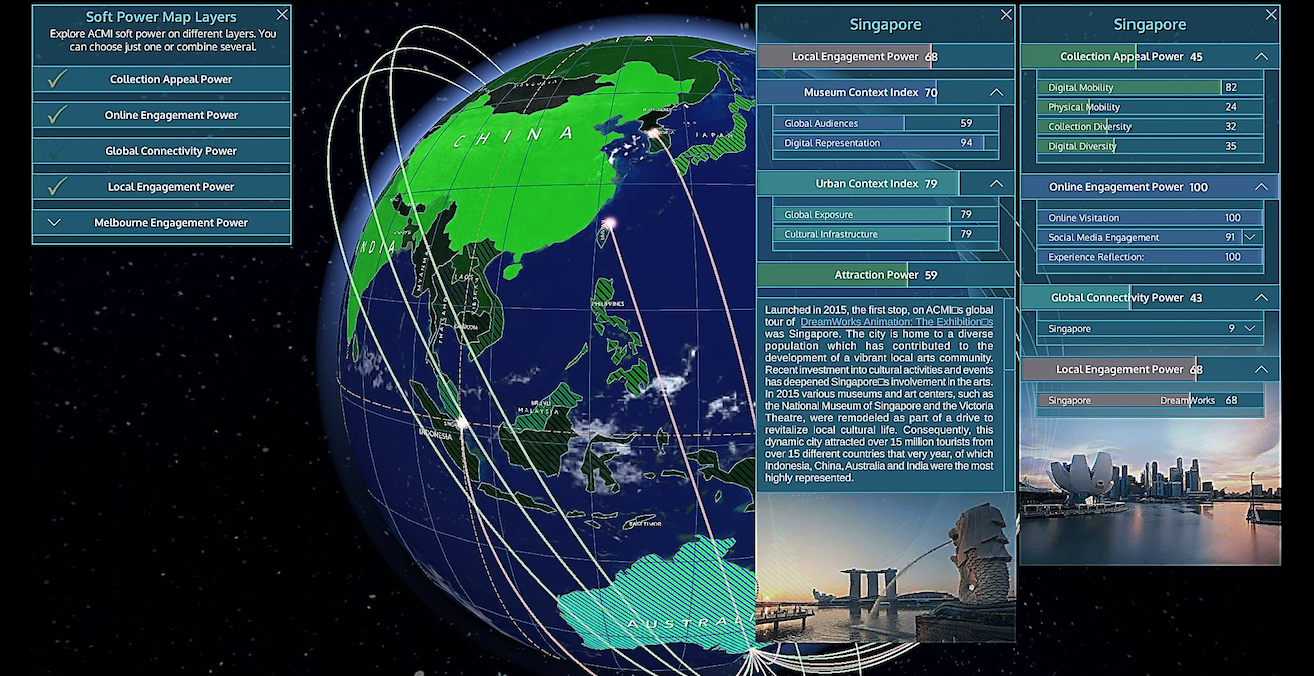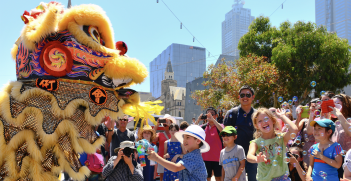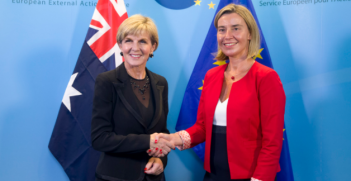The Geo-Visualisation of Australian Soft Power: From Measuring to Forecasting

A newly-developed Soft Power Map visualises the attraction of museums in global cities and, with the development of a forecasting layer, could help Australia to better generate cultural attraction.
Australia can no longer afford to see Asia as its faraway, alien or mysterious backyard in the Asia-Pacific geographic region. The Australian Government in its 2012 Asian Century White Paper stressed the growing economic power of Asia and urged the country to embrace changes and rethink the national strategic objectives for the next decades. To manage and shape the national future in the era of rapid “transformation of the Asian region into the economic powerhouse of the world,” Australia strives to create deeper connections with Asia to broaden the flow of ideas and exchange of knowledge and capabilities.
Media connectivity, international cultural relations and people-to-people exchanges play one of the key roles in the national plans of sizing the potential of the “Asian century.”
But how do we comprehend, evaluate and leverage the Australian soft power generated by these exchanges and facilitated by Australian premier cultural institutions? The Deep Mapping experimental research project offered a solution to these challenges. Trialling a demo version of its first-in-the-world digital mapping system, this app not only measures museum soft power but also visualises it on the global map. Developed in collaboration with the Australian Centre of the Moving Image (ACMI), the project designed a pilot web application, the ACMI Soft Power Map, a focused, single-museum online tool to geo-visualize and assess the museum’s “attraction power” in Melbourne and abroad.
This platform uses geo-visualisation, data mining, digital storytelling and data-curation techniques to explore correlations in geographical layers of museum data, including between collections, online and onsite audiences, international activities and constituencies. The deep mapping system contains five key layers, from mere resources to strategic outputs and to targeted response. The digital mapping system measures audience engagement power across three layers: global online followers, local Melbourne audience and international visitors to ACMI touring exhibitions that in the last decade travelled to 16 hosting cities across Asia-Pacific, Europe and Americas.
A series of blockbuster exhibitions ACMI developed in collaboration with one of the largest Hollywood producers, DreamWorks Animation, proved to be highly successful among Asian audiences. This exhibition travelled across Asia-Pacific in 2015-2017 and was hosted by a number of museums, such as the ArtScience Museum in Singapore, the Te Papa Museum in New Zealand, the Seoul Museum of Art in South Korea and the National Taiwan Science and Education Centre. The recently completed focused research project revealed and explained local and global mechanisms of “attraction” power generated by ACMI blockbuster in different Asian countries.
When compared across three cities — Singapore, Seoul and Taipei — it was revealed that DreamWorks Animation Blockbuster was received exceptionally well in Asia, with the highest Local Attraction Power Index in Singapore (55). Singapore is the leading hosting city of DreamWorks Animation in Asia in terms of its “attraction” power. The city enjoys strong global connectivity and exposure (Global Exposure Index 79) and has larger and more diverse onsite and online audiences in the ArtScience Museum (Global Audiences Index 59), one of the most important city landmarks. DreamWorks Animation blockbuster was visited twice as much in Singapore’s ArtScience Museum, compared with the Museum of Art in Seoul and the National Taiwan Science and Education Centre.
This Local Engagement Power Index makes more sense when correlated to data across four layers of ACMI Soft Power Map. In comparison to South Korea and Taiwan, Singapore has much higher indicators for ACMI Collection Appeal (45), Online Engagement (100) and Global Connectivity (43). In terms of the Collection Appeal Index, the three official languages in Singapore — English, Chinese, Tamil and Malay — significantly increase the level of access and potential interests in the diverse ACMI multicultural collections. The high Online Engagement Index shows that multilingual and multicultural Singapore, with its high internet penetration rate, is well placed to establish multidirectional digital links with ACMI through numerous online communication activities.
As for the institutional connectivity, ACMI established strong relationships with key cultural institutions in Singapore, including local museums and international festivals. This favourable national environment in Singapore, where ACMI has already established durable organizational affiliations and achieved a strong brand recognition, provided a robust background for the DreamWorks blockbuster to engage and attract local audiences. As co-presidents of DreamWorks Feature Animation, Bonnie Arnold and Mireille Soria, emphasized, “ArtScience Museum in Singapore is the perfect venue to celebrate the incredible artistry of DreamWorks Animation’s films and we are thrilled to have them serve as the first host on our exhibition’s world tour.”
Unsurprisingly, the new ACMI blockbuster exhibition “Wonderland” also started its global tour in April 2019 from Singapore.
This mega-popular exhibition is currently on display at the ArtScience Museum until September 2019, from where it will continue its global journey. In May 2019 the unique Museum Soft Power Map developed a new layer, the Local Engagement Power Forecast, which predicts the soft power of the ACMI international blockbuster. This layer forecasts the soft power of the traveling exhibition “Wonderland” in potential hosting cities across continents. Employing algorithmic modelling and drawing on the results of measuring the soft power of previous traveling exhibitions in different places, the mapping system calculates potential local impacts of the traveling blockbuster, taking into account multiple factors. These factors include the local urban environment, the museum’s context and the cultural relevance of the exhibition’s content to local audiences. This allows AMCI to predict the attendance numbers of this exhibition and forecast its potential outcomes.
Among 17 potential cities where “Wonderland” might travel in the next decade — from Los Angeles to Taipei — Singapore is again a leading city in the Asia Pacific with the Local Engagement Power Forecast index reaching 59, outperforming Berlin, Paris and Tokyo among other cities. This forecast layer is a significant step forward in our understanding of soft power, offering a new strategic development tool for cultural institutions in Australia to shape and target their efforts across countries to better generate cultural attraction. With the Australian Government seeking innovative and reliable approaches and tools to measure its soft power, the ACMI Soft Power Map offers a robust platform to address these tasks.
Dr Natalia Grincheva is a research fellow in the Research Unit of Public Cultures at the University of Melbourne. She is a lead CI and conceptual designer of the digital mapping system Museum Soft Power Map.
This article is published under a Creative Commons Licence and may be republished with attribution.





